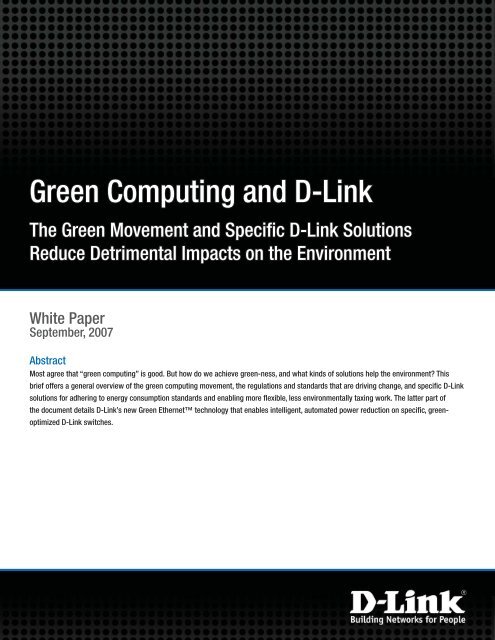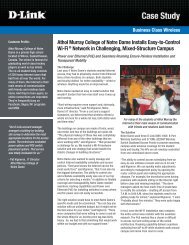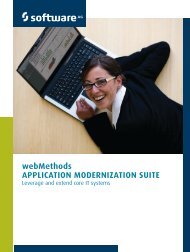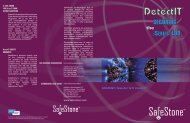Green Computing and D-Link
D-Link Green White Paper - Freelance Technology Marketing Writer
D-Link Green White Paper - Freelance Technology Marketing Writer
- No tags were found...
You also want an ePaper? Increase the reach of your titles
YUMPU automatically turns print PDFs into web optimized ePapers that Google loves.
<strong>Green</strong> <strong>Computing</strong> <strong>and</strong> D-<strong>Link</strong>The Need for <strong>Green</strong>Technology pollutes. Power consumption related to technology isrising rapidly. According a recent U.S. Environmental ProtectionAgency (EPA) report, the IT industry consumed approximately 61billion kilowatt-hours of electricity in 2006. That’s 1.5 percent ofthe total electricity consumed in the United States. The power billis roughly $4.5 billion. Servers <strong>and</strong> data centers deployed by theU.S. Federal Government account for about 10 percent, or 6 billionkWh, of the total consumption. The report estimated that IT powerconsumption could nearly double by 2011.The proliferation of data centers requires the constant addition ofservers <strong>and</strong> requisite cooling <strong>and</strong> ventilation equipment – which allconsume copious amounts of electricity. Lead, mercury, cadmium,<strong>and</strong> other toxic elements in the materials that compose hardwareendanger the health of humans <strong>and</strong> the planet.Fortunately, technology also helps us heal the planet <strong>and</strong> protectecosystems that support life. Better cooling, server <strong>and</strong> ventilationdesigns are helping reduce the amount of power needed for datacenters dramatically. New computers, laptops, <strong>and</strong> networkingproducts are being designed with safer materials <strong>and</strong> built-inrecycling programs. And, the continued proliferation of networksenables workers to work remotely, travel less, <strong>and</strong> decrease burdenson transportation systems, <strong>and</strong> thus the environment.Consumers, business leaders, <strong>and</strong> organizations of all kinds havedeveloped a new enthusiasm for environmental consciousness.Awareness is at an all-time high. Across the globe, people aredem<strong>and</strong>ing more environmentally friendly products, st<strong>and</strong>ardsbodies are creating <strong>and</strong> enforcing better design, disposal, <strong>and</strong>electricity consumption regulations, <strong>and</strong> technology manufacturersare delivering solutions that enable high-performance computingwhile satisfying ecological concerns.<strong>Green</strong> is good. New initiatives are taking hold <strong>and</strong> quickly producingresults throughout the entire IT industry.Why Go <strong>Green</strong>?There are several general reasons why green is good. Being green– purchasing green equipment, designing <strong>and</strong> building greensolutions, paying attention to energy consumption, <strong>and</strong> disposing of<strong>and</strong> recycling hardware conscientiously – helps you:• Save cash on energy costs• Comply with government regulations• Meet increasing customer dem<strong>and</strong>s for cleaner, moreeco-friendly products• Appeal to consumers <strong>and</strong> partners who want to patronize<strong>and</strong> associate with green companiesSeptember, 2007Those are direct benefits. The ultimate benefits are even morecompelling. Caring for the environment <strong>and</strong> actively taking steps toprotect it benefits:• The planet• The health of animals, humans <strong>and</strong> flora• The health <strong>and</strong> prosperity of future generations<strong>Green</strong> initiatives of gr<strong>and</strong> or even seemingly minor significance helpheal the planet, <strong>and</strong> make it beautiful <strong>and</strong> clean. Drinking water <strong>and</strong>food supply quality can improve. Fragile biological processes stayin check, food chains remain intact, <strong>and</strong> there is less impact on theplanet’s ozone layer.Quick DefinitionsEPA ENERGY STAR ® : The voluntary U.S. electronics manufacturinglabeling program designed to promote <strong>and</strong> recognize energy-efficiency in computers, monitors, climate control equipment, majorappliances, lighting, <strong>and</strong> other technologies. Sleep mode was widelyadopted due to the initial ENERGY STAR program that launched in1992. A new ENERGY STAR specification for desktop computerswent into effect on July 20th, 2007. The requirements are morestringent than the previous specification <strong>and</strong> existing equipmentdesigns can no longer use the logo unless re-qualified. The powerrequirements are for 80% or greater AC power supply efficiencyusing the st<strong>and</strong>ards defined by the 80 PLUS Program.EElectronic Products Environmental Assessment (EPEAT): Anenvironmental st<strong>and</strong>ard <strong>and</strong> rating system that makes it easier forcomputer purchasers to buy computers, laptops <strong>and</strong> monitors thatmeet stringent environmental criteria. The system was developedwith funding from the U.S. EPA. The st<strong>and</strong>ard was adopted by theInstitute for Electrical <strong>and</strong> Electronics Engineers as IEEE 1680through an ANSI-accredited process.RoHS (Restriction of Hazardous Substances): Adopted in February2003 by the European Union <strong>and</strong> in effect since July 1, 2006, theRoHS directive restricts the use of six hazardous materials (lead,mercury, cadmium, hexavalent chromium [chromium xxx or Cr6+],polybrominated biphenyls [PBB], <strong>and</strong> polybrominated diphenylether [PBDE]) in the manufacture of various types of electronic <strong>and</strong>electrical equipment. The directive is closely linked with the WasteElectrical <strong>and</strong> Electronic Equipment Directive (WEEE) (see below).Electrical <strong>and</strong> Electronic Equipment Directive (WEEE): EuropeanUnion directive which sets collection, recycling <strong>and</strong> recovery targetsfor electrical goods <strong>and</strong> is part of a legislative initiative to solve theproblem of huge amounts of toxic e-waste. Manufacturers becamefinancially responsible for compliance to the WEEE directive inAugust of 2005. By the end of 2006 – <strong>and</strong> with one or two years’delay for the new EU members – every country has to recycle atleast 4 kg of e-waste per capita.*2
<strong>Green</strong> <strong>Computing</strong> <strong>and</strong> D-<strong>Link</strong>manage the lifecycle of products. Companies are offering recyclingoptions, so consumers can be assured that their equipment will beappropriately recycled <strong>and</strong> disposed of after they are finished usingit. Large organizations are already including disposal <strong>and</strong> recyclingcomponents in their hardware RFPs. These steps will go a longway toward shrinking <strong>and</strong> cleaning up l<strong>and</strong>fills, re-using valuablematerials, <strong>and</strong> reducing e-waste.3. Enable Lifestyle Changes that Lower Impact on the EnvironmentNetwork connectivity <strong>and</strong> mobility reduce the need to commute tomeetings <strong>and</strong> appointments, saving travel time, fuel, <strong>and</strong> wear onthe world’s travel infrastructure. Similarly, IP video solutions reducethe need for in-person meetings <strong>and</strong> support personnel on thepremises for surveillance. State-of-the-art wireless solutions allowpeople to work conveniently almost everywhere. The proliferation ofWi-Fi hot-spot <strong>and</strong> WiMax networks will only extend this trend.Power Saving Tips• Lower electricity consumption by manually or automaticallyturning off monitors• Use LCD monitors that consume less power than CRT monitorsof the same size• Use a laptop. They consume less power than desktops, <strong>and</strong> manyhave connections for full sized monitor, keyboard, mouse,<strong>and</strong> speakersD-<strong>Link</strong> SolutionsD-<strong>Link</strong> spends significant resources <strong>and</strong> time pursuing greencomputing initiatives <strong>and</strong> designing energy-saving, waste-reducingfeatures into our products. Many of our products feature ENERGYSTAR compliance, which allows our customers to save energy <strong>and</strong>more easily manage the power dem<strong>and</strong>s of their D-<strong>Link</strong> equipment.We maintain strict compliance with existing governmental st<strong>and</strong>ardsfor energy conservation <strong>and</strong> waste reduction. We also take thingsa bit further, designing green computing features into our productsbefore government m<strong>and</strong>ates <strong>and</strong> industry st<strong>and</strong>ards commence.Many of our solutions enable remote work <strong>and</strong> mobility,bringing people closer together without needlessly spendingfuel, <strong>and</strong> consuming travel <strong>and</strong> infrastructure resources. Ourrouters, switches, IP cameras, VoIP solutions, <strong>and</strong> wide rangeof Wi-Fi solutions enable flexible working arrangements <strong>and</strong>teleconferencing, for example.New Networking St<strong>and</strong>ards for Lower Power StatesD-<strong>Link</strong> networking equipment features advanced powermanagement capabilities that go beyond the IEEE Energy EfficientEthernet St<strong>and</strong>ard. The IEEE st<strong>and</strong>ard aims to reduce powerconsumption in switches by automatically powering down, idling ormoving to different transfer rates. D-<strong>Link</strong> executives do not expectproducts based on the IEEE st<strong>and</strong>ard to arrive until 2012, so theSeptember, 2007company has pushed its own internal initiative to include advancedpower management, auto-sensing, <strong>and</strong> state-detection featuresin all our switches, routers, access points, cameras <strong>and</strong> storagedevices.More specifically, D-<strong>Link</strong> products designed with our new <strong>Green</strong>Ethernet technology are arriving year-end 2007. The technologyenables smart, automated power consumption reduction on ourDGS-2208 8-Port 10/100/1000 desktop switch <strong>and</strong> our DGS-22055-Port 10/100/1000 desktop switch. When nodes, like servers,clients <strong>and</strong> storage systems, are attached to these specializedswitches, they can automatically detect power-down events <strong>and</strong>stop sending ping packets to the nodes, thereby saving power.The switches also detect cable length <strong>and</strong> adjust powerconsumption accordingly. With the DGS-2205, maximum powersavings is 44%, <strong>and</strong> normal day power savings is 27%. With theDGS-2208, maximum power savings is 80%, <strong>and</strong> normal day powersavings is 40%D-<strong>Link</strong> is the first company to market with this advancedtechnology. D-<strong>Link</strong> EMEA has already shipped <strong>Green</strong> Ethernetproducts that adhere to RoHS regulations <strong>and</strong> include green,recyclable packaging.Certified Wireless USB Adapters – Faster than Bluetooth WhileRequiring Less Power than Wi-FiD-<strong>Link</strong> <strong>and</strong> IOGear announced Certified Wireless USB adaptersthat plug into USB ports. Wireless USB uses ultrawideb<strong>and</strong> (OWB)technology, which enables short-range connections (15 to 30 feet)at much faster speeds (up to 480Mbps at 10 feet <strong>and</strong> 110 Mbpsat 30 feet) than Bluetooth while consuming much less power thanWi-Fi. The adapters are the first products to receive Wireless USBCertification from the USB Implementers Forum.Eventually, the adapters will connect to a new generation ofperipherals that will also carry embedded wireless USB. Currentlythe products are used with legacy USB peripherals connectedto wireless USB hubs. The adapters can be used to connect toa conventional USB printer plugged into a wireless USB hub,for example.Regulatory ComplianceD-<strong>Link</strong> is an ENERGY STAR partner for end-use productsincorporating single voltage external ac-dc or ac-ac power supplies.D-<strong>Link</strong> supports the European Union’s RoHS directive. We alsosupport local programs for the recycling, reuse, <strong>and</strong> reclamation ofconsumer goods, including our products <strong>and</strong> packaging.The safety <strong>and</strong> integrity of our products is key to our relationshipwith our customers. Certain chemicals <strong>and</strong> substances becomelabeled as “Hazardous Materials” due to government, industry <strong>and</strong>4
<strong>Green</strong> <strong>Computing</strong> <strong>and</strong> D-<strong>Link</strong>consumer concerns. When those issues are raised <strong>and</strong> materialsare identified, D-<strong>Link</strong> is the first to acknowledge those bans <strong>and</strong>guarantee the safety of our products for the end-user.Committed to the PlanetD-<strong>Link</strong>’s commitment to green issues <strong>and</strong> initiatives pervades everycorner of our organization. We back up our green talk with strategicinitiatives as well as personal dedication to environmental practices atwork <strong>and</strong> at home. We want to clean up the planet, protect the healthof fragile ecosystems, ensure clean food <strong>and</strong> water supplies, <strong>and</strong>make the world a better place for generations to come, just like you.For more information on D-<strong>Link</strong>’s green products <strong>and</strong> practices,please visit http://www.dlink.com/corporate/environment/. Ourgreen programs are constantly evolving, so check back to see newdevelopments.September, 20075






